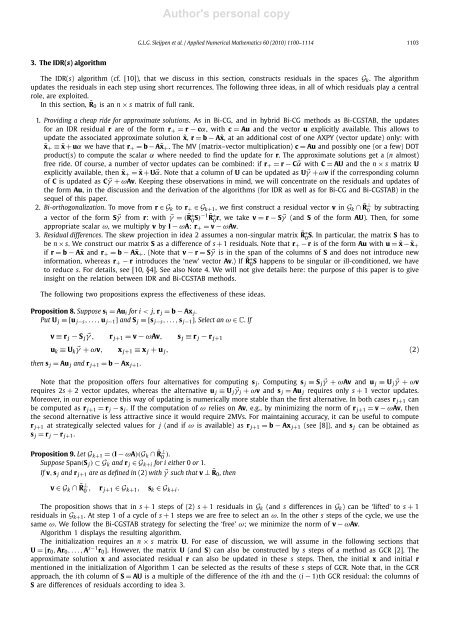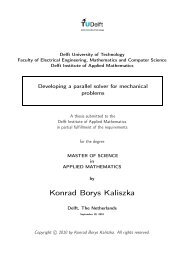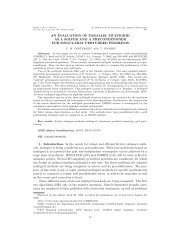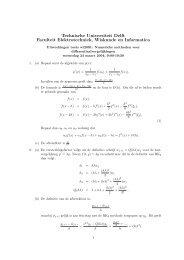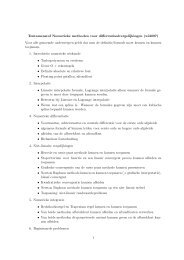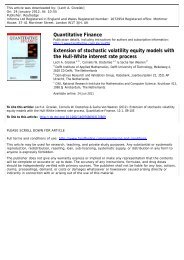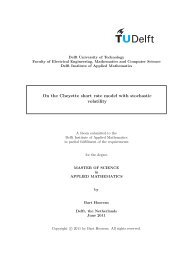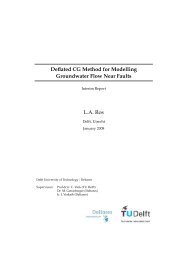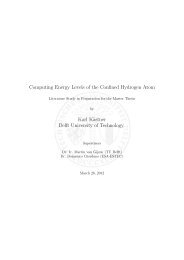Gerard L.G. Sleijpen, Peter Sonneveld and Martin B. van Gijzen, Bi ...
Gerard L.G. Sleijpen, Peter Sonneveld and Martin B. van Gijzen, Bi ...
Gerard L.G. Sleijpen, Peter Sonneveld and Martin B. van Gijzen, Bi ...
You also want an ePaper? Increase the reach of your titles
YUMPU automatically turns print PDFs into web optimized ePapers that Google loves.
Author's personal copy<br />
G.L.G. <strong>Sleijpen</strong> et al. / Applied Numerical Mathematics 60 (2010) 1100–1114 1103<br />
3. The IDR(s) algorithm<br />
The IDR(s) algorithm (cf. [10]), that we discuss in this section, constructs residuals in the spaces G k . The algorithm<br />
updates the residuals in each step using short recurrences. The following three ideas, in all of which residuals play a central<br />
role, are exploited.<br />
In this section, ˜R0 is an n × s matrix of full rank.<br />
1. Providing a cheap ride for approximate solutions. As in <strong>Bi</strong>-CG, <strong>and</strong> in hybrid <strong>Bi</strong>-CG methods as <strong>Bi</strong>-CGSTAB, the updates<br />
for an IDR residual r are of the form r + = r − cα, withc = Au <strong>and</strong> the vector u explicitly available. This allows to<br />
update the associated approximate solution ˜x, r = b − A˜x, at an additional cost of one AXPY (vector update) only: with<br />
˜x + ≡ ˜x + uα we have that r + = b − A˜x + . The MV (matrix–vector multiplication) c = Au <strong>and</strong> possibly one (or a few) DOT<br />
product(s) to compute the scalar α where needed to find the update for r. The approximate solutions get a (n almost)<br />
free ride. Of course, a number of vector updates can be combined: if r + = r − C⃗α with C = AU <strong>and</strong> the n × s matrix U<br />
explicitly available, then ˜x + = ˜x + U⃗α. Note that a column of U can be updated as U ⃗γ + ωv if the corresponding column<br />
of C is updated as C ⃗γ + ωAv. Keeping these observations in mind, we will concentrate on the residuals <strong>and</strong> updates of<br />
the form Au, in the discussion <strong>and</strong> the derivation of the algorithms (for IDR as well as for <strong>Bi</strong>-CG <strong>and</strong> <strong>Bi</strong>-CGSTAB) in the<br />
sequel of this paper.<br />
2. <strong>Bi</strong>-orthogonalization. Tomovefromr ∈ G k to r + ∈ G k+1 , we first construct a residual vector v in G k ∩ ˜R⊥<br />
0<br />
by subtracting<br />
avectoroftheformS ⃗γ from r: with ⃗γ = ( ˜R∗<br />
0 S)−1 ˜R∗<br />
0r,wetakev = r − S ⃗γ (<strong>and</strong> S of the form AU). Then, for some<br />
appropriate scalar ω, wemultiplyv by I − ωA: r + = v − ωAv.<br />
3. Residual differences. The skew projection in idea 2 assumes a non-singular matrix ˜R∗<br />
0S. In particular, the matrix S has to<br />
be n × s. We construct our matrix S as a difference of s + 1 residuals. Note that r + − r is of the form Au with u = ˜x − ˜x +<br />
if r = b − A˜x <strong>and</strong> r + = b − A˜x + . (Note that v − r = S ⃗γ is in the span of the columns of S <strong>and</strong> does not introduce new<br />
information, whereas r + − r introduces the ‘new’ vector Av.) If ˜R∗<br />
0S happens to be singular or ill-conditioned, we have<br />
to reduce s. For details, see [10, §4]. See also Note 4. We will not give details here: the purpose of this paper is to give<br />
insight on the relation between IDR <strong>and</strong> <strong>Bi</strong>-CGSTAB methods.<br />
The following two propositions express the effectiveness of these ideas.<br />
Proposition 8. Suppose s i = Au i for i < j, r j = b − Ax j .<br />
Put U j ≡[u j−s ,...,u j−1 ] <strong>and</strong> S j ≡[s j−s ,...,s j−1 ]. Select an ω ∈ C.If<br />
v ≡ r j − S j ⃗γ , r j+1 = v − ωAv, s j ≡ r j − r j+1<br />
u k ≡ U k ⃗γ + ωv, x j+1 ≡ x j + u j , (2)<br />
then s j = Au j <strong>and</strong> r j+1 = b − Ax j+1 .<br />
Note that the proposition offers four alternatives for computing s j . Computing s j ≡ S j ⃗γ + ωAv <strong>and</strong> u j ≡ U j ⃗γ + ωv<br />
requires 2s + 2 vector updates, whereas the alternative u j ≡ U j ⃗γ j + ωv <strong>and</strong> s j = Au j requires only s + 1 vector updates.<br />
Moreover, in our experience this way of updating is numerically more stable than the first alternative. In both cases r j+1 can<br />
be computed as r j+1 = r j − s j . If the computation of ω relies on Av, e.g., by minimizing the norm of r j+1 = v − ωAv, then<br />
the second alternative is less attractive since it would require 2MVs. For maintaining accuracy, it can be useful to compute<br />
r j+1 at strategically selected values for j (<strong>and</strong> if ω is available) as r j+1 = b − Ax j+1 (see [8]), <strong>and</strong> s j can be obtained as<br />
s j = r j − r j+1 .<br />
Proposition 9. Let G k+1 = (I − ωA)(G k ∩ ˜R⊥<br />
0 ).<br />
Suppose Span(S j ) ⊂ G k <strong>and</strong> r j ∈ G k+i for i either 0 or 1.<br />
If v, s j <strong>and</strong> r j+1 are as defined in (2) with ⃗γ such that v ⊥ ˜R0 ,then<br />
v ∈ G k ∩ ˜R⊥ 0 , r j+1 ∈ G k+1 , s k ∈ G k+i .<br />
The proposition shows that in s + 1stepsof(2)s + 1 residuals in G k (<strong>and</strong> s differences in G k )canbe‘lifted’tos + 1<br />
residuals in G k+1 . At step 1 of a cycle of s + 1 steps we are free to select an ω. In the other s steps of the cycle, we use the<br />
same ω. We follow the <strong>Bi</strong>-CGSTAB strategy for selecting the ‘free’ ω; we minimize the norm of v − ωAv.<br />
Algorithm 1 displays the resulting algorithm.<br />
The initialization requires an n × s matrix U. For ease of discussion, we will assume in the following sections that<br />
U =[r 0 , Ar 0 ,...,A s−1 r 0 ].However,thematrixU (<strong>and</strong> S) can also be constructed by s steps of a method as GCR [2]. The<br />
approximate solution x <strong>and</strong> associated residual r can also be updated in these s steps. Then, the initial x <strong>and</strong> initial r<br />
mentioned in the initialization of Algorithm 1 can be selected as the results of these s steps of GCR. Note that, in the GCR<br />
approach, the ith column of S = AU is a multiple of the difference of the ith <strong>and</strong> the (i − 1)th GCR residual: the columns of<br />
S are differences of residuals according to idea 3.


